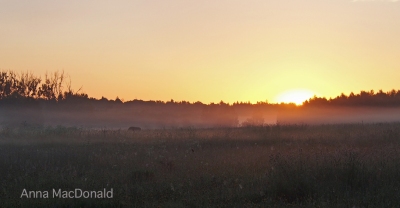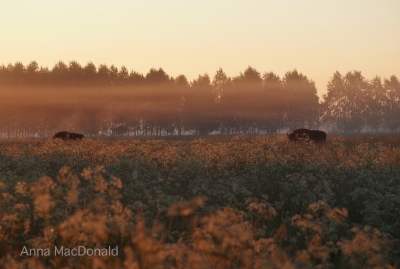At first they were just shadows, dark impressions glimpsed through the mist. Is that really…? Could it be…? As we moved a little closer one of them turned to the east, to face the rising sun. His profile was unmistakable, the curved horns and humped shoulders proclaiming “bison”!

And not just any bison, but free-ranging European bison, grazing in the meadows on the edge of the largest remnant of primeval forest in Europe. Without a doubt, this encounter during my visit to Poland in July was the stand-out wildlife experience of my year. With an emphasis on WILD. I suspect that experience is also what prompted this post, on the topic of rewilding.

Rewilding. It’s an evocative word. It’s also a word that seems to turn up quite regularly in my news feeds at the moment. Every so often, friends ask me what I think about rewilding. To answer them I wanted to gain a better understanding of some of the issues surrounding rewilding, so I thought I’d do a little reading, then write a quick blog post on the topic.
Well, that was a mistake! I’ve just emerged from one of those internet black holes, following one link after another, browsing paper after news article after blog, reading about some wonderful conservation projects, outlandish ideas (some good, some… less good) and first person perspectives from all sides of the debate.
So what have I learned?
Well… it’s complicated.
And I think when we get down to it, that is the crux of the issue. Rewilding IS complicated. On the one hand, popularising the idea of rewilding is a fantastic way to get people engaged with concepts like trophic cascades, keystone species and ecosystem engineers. Wrap that up in tales of long-lost landscapes and charismatic megafauna, and there are great opportunities to communicate science. On the other hand, not all rewilding proposals are created equal. There are many different definitions, motivations, benefits and drawbacks to rewilding, and these are entirely dependent on context: where, how, which species, for what purpose, how will people be affected… It would be a mistake to think of or to portray rewilding as a single thing, an entity about which definitive decisions should be made, that one must be either “for rewilding”, or else against the idea as a whole. Instead, we need to consider each proposal in turn, look at the pros and cons, and make decisions on a case-by-case basis.
There’s a great deal of information already available on this topic. Rather than try to write an exhaustive post myself, I’m going to tackle a few questions and provide links to some resources that I thought were interesting.
What is rewilding?
There are numerous definitions of and different approaches to rewilding, but in the ecological context these generally refer to the introduction of species (or, where those species are now extinct, substitutes that fill a similar ecological role) to areas where they no longer occur, to restore ecosystems to a more natural state. To some extent, this means that rewilding shares aims with restoration ecology, although there are differences between traditional approaches to restoration and newer frameworks for rewilding.
Where are rewilding projects happening, or being proposed?
Rewilding is an idea that is gaining traction globally, in Britain (see here, here and here), Europe (see here and here), Australia, North America, South America and Asia.
Why bother?
The motivations for rewilding are diverse, including aesthetic and emotional desires to restore what has been lost, and more pragmatic desires to restore missing functionality to modern ecosystems. From an ecological perspective, the most popular rewilding efforts focus on returning keystone predators to restore trophic cascades, and returning species that act as ecosystem engineers to restore the natural functioning of waterways, landscapes and nutrient cycles. Rewilding can also provide new tourism opportunities: people like to see charismatic wildlife in natural settings, and successful rewilding programs have become tourism attractions in, for example, Australia, Scotland and Germany.
Does it work?
If we put aside all the hype, is rewilding plausible, and will it actually benefit ecosystems? There are already a handful of poster children for the rewilding movement, and many more projects still at the early stages of evaluation.
The reintroduction of wolves to Yellowstone, in the US, has been touted as an ecological success story, that provides convincing evidence of the importance of top-order predators for the maintenance of healthy ecosystems. Likewise, the spread of beavers in the British Isles, which we’ve previously covered at WildlifeSNPits, has clear potential to restore wetlands and improve the ability of landscapes to resist both droughts and floods.

In Europe, bison (or wisent) are slowly regaining some of their former range, following their extinction in the wild as recently as the 1920s. From a stronghold in the Białowieża forest in Poland (where I was lucky enough to see them earlier this year) they have now been reintroduced to nine countries, including Germany and the Netherlands, where their grazing is already having a positive effect on overgrown dunes in the Zuid-Kennemerland National Park.
In Australia, eastern bettongs have recently been introduced to Mulligan’s Flat, a reserve near Canberra that is fenced to exclude non-native predators. These small marsupials, which are related to kangaroos, became extinct in mainland Australia almost a hundred years ago, but persist in Tasmania, which is the source of the introduced population. Bettongs, like many similar marsupials, are important ecosystem engineers because their foraging behaviour, which involves copious digging, improves the movement of nutrients and water through the soils and helps to disperse seeds and fungi. Research is ongoing to discover how the reintroduction of bettongs affects the ecosystem at Mulligan’s Flat.
Do you have to be a mammal to qualify for rewilding?
You might have noticed that all of the examples I’ve shared so far have involved mammals. This may reflect our own inherent biases and preferences for cute and fluffy creatures, and the tendency for people to better relate to – and support – proposals involving mammals. But rewilding is not for mammals alone. For example, several bird and fish species have been suggested as suitable targets for rewilding in Britain, while the return of the sea eagle is an early British rewilding success.
I’m not aware of any rewilding projects that involve invertebrates, which is a shame because it seems as though it would be much simpler to implement the rewilding of declining invertebrate pollinators than that of large, potentially dangerous, vertebrates. But perhaps these projects are happening, but without the rewilding hype? In fact, if you think about it, organisations such as Greening Australia already engage in rewilding of a sort, as do many gardeners who have discarded their ornamental cultivars to create native wildlife-friendly gardens. But perhaps we don’t think about those efforts in quite the same way, because the act of planting trees doesn’t evoke quite the same emotions as the act of releasing mysterious elusive mammals to live among them.
Rewilding conflicts
Every rewilding project involves risks and will likely attract some opposition. Fortunately for me, this timely post outlines many of the negatives of rewilding, so I don’t need to write about them in detail. There are still many things we need to understand if we are going to get rewilding right, but small-scale trials may help to determine risks and identify effective measures that will be socially and politically acceptable. For some projects there will likely always be limitations. In Britain, proposals to introduce predators such as lynx and wolves have attracted as much negative attention as positive, which is understandable when you consider the dangers posed by predators to peoples’ lives and livelihoods. Despite the success of the reintroduction of sea eagles to Scotland, their impacts on sheep farming remain unpopular. In cases such as these, all who have a stake in rewilding need to be engaged. It may never be possible to have free-ranging wolves near heavily-populated Scottish cities, but perhaps a large, enclosed nature reserve could act as a compromise.
How far should we go?
If the aim of rewilding is to restore ecosystem function, how do we decide WHICH ecosystem to focus on? Some ecosystems have changed dramatically over recent geological time. How far back in time should we aim to go? Do we try to bring back species that were lost in the last century… or the last millenium… or even further back? Does it matter if we don’t bring back exactly the same species? Globally, much of the Pleistocene megafauna is now extinct, but these animals played important roles in their ecosystems, so should we try to replace them? This article provides a good overview of some of the pros and cons of Pleistocene rewilding.
If we decide we are in favour of the Pleistocene rewilding concept, can we bring some of those extinct species back to life? There’s been much debate about de-extinction of species like the woolly mammoth, with arguments from scientists both for and against the idea. Perhaps a more realistic target is the auroch, the ancestor of all modern cattle, which became extinct several hundred years ago. One proposal suggests cross-breeding modern lines of cattle, to create a new breed with an old genome, bringing all the auroch genes back together again. In scenarios like this, de-extinction might be achievable, but should it be done? How much effort (and money) should go into saving extinct species, when we already struggle to fund conservation of the wildlife we have left?
Another option involves rewilding with “proxy” species. There have been proposals to introduce species such as lions and cheetahs to North America, and elephants and komodo dragons to Australia, as substitutes for species that are now extinct in the region. Unsurprisingly, such ideas are controversial! However, more sensible and easily achievable strategies might focus on the translocation of wildlife from nearby populations to replace closely-related fauna and flora lost from island ecosystems.

So let’s go back to the original question… what do I think about rewilding?
Well, I think I’m still going to give the same answer: “It depends…” But let me indulge myself and finish this post with one scenario that I think is worth exploring. Why not bring the Tasmanian devil back to mainland Australia? This has twofold benefits: additional disease-free insurance populations for the world’s largest extant marsupial carnivore, and restoration of a native predator to dysfunctional mainland ecosystems. Obviously this shouldn’t be a devil free for all: start with trial populations in contained reserves and take it from there. Interested in learning more? Read about the idea in these articles by Euan Ritchie, Daniel Hunter and Mike Letnic, Billy Geary and Rewilding Australia.
This is a fascinating article. Thank you. My weightiest argument in favor of rewilding is the need to maintain the range of wild species with shares in our environment. Each extinction is a further contraction, no matter how little the eco-system is affected. It’s great to see attempts to re-settle beavers here in UK, for example.
Hi Frederick, thanks for your comment. I’m sorry, I must have missed this when you first posted it. I’m glad you found the article interesting. I would love to see beavers in the UK – they would have made my childhood a lot more interesting!